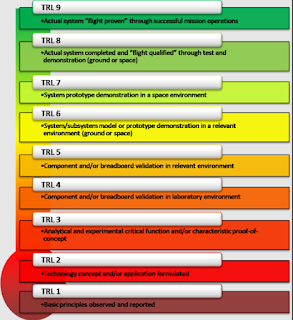Design Principle #4 for 84% Innovation Adoption – Technology Readiness Level
This series of blog posts describes the principles relevant for designing an innovation for rapid adoption by 84% of a target group. 84% adoption is the threshold for achieving sustainable change.
The underlying theory stems from the
"invisible college" around Rogers, E.M. (2003) “Diffusion of
Innovations.” which reminds us that adopters are grouped as Innovators 2%,
Early Adopters 14%, Early Majority 34%, Late Majority 34% and Laggards 16%.
Designing innovations (and the change intended by them) to reach the Late
Majority is a very different game than that typically "played" (which
actually only focuses on the Innovators and Early Adopters). Such
"designs" depend on understanding our own body of work which
skilfully integrates systems thinking, living systems principles, complexity
thinking etc. None of the design principles we will discuss are “innovative” –
it their blending and orchestration to achieve 84% adoption that is the art of
“deep diffusion” we master.
Design Principle #4: Technology
Readiness Level
Technology Readiness Level (TRL)
describes the maturity of a product in respect to being used in an operational
environment. TRL can be applied to services as well. TRL does NOT refer to the
use of a product/service to achieve a specific benefit (i.e., commercially or
regarding a specific behavioural change. See also https://en.wikipedia.org/wiki/Technology_readiness_level.
The higher a TRL the easier the “use” by late adopters is in general.
In practice it can help to agree on the
TRL with focus groups from the relevant adopter category. Ideally each adopter
category re-designs a product/service to meet the TRL expectations of the next
adopter group and thus each adopter group receives a different version;
innovation get the “beta version”, early adopters get version 1.0, the early
majority gets 2.0, the late majority gets 3.0 and laggards, well get version
4.0+.
As an example, we might be diffusing a
vertical farming solution for supermarkets. The solution consists both of a “product”
in the sense of a growing cabinet and a “service” for using it (i.e., cleaning,
replenishment etc.). When the solution is “sold” to supermarkets (chains) then
it must be at TRL 9 (fully ready for use), due to many legal requirements. On
the way to TRL 9 the solution may also have been continuously co-created with
later buyers – it is during this co-creation process that the TRLs are run
through. Hereby it is not uncommon for TRL 1 & 2 to be completed by
research institutes, TRL3-6 to be co-created, TRL 7&8 is usually achieved with
scaling partners. The first supermarkets (chains) to “buy” are then typically
innovators and even they will start with small pilots in a few stores to see
how things go! The “late adopters” are then often those stores where consumers would
not like to take risks. Interesting enough there is a strong correlation to cultural
preferences here as well – check out https://www.hofstede-insights.com/country-comparison/
to especially review cultural attitudes to uncertainty / innovation.
So… are you aligning TRL progression planning
against your adopter groups?
Image from https://www.nasa.gov/sites/default/files/trl.png
Previous Design Principles
Design
Principle #1 for 84% Innovation Adoption – Aiming for 84%
Design
Principle #2 for 84% Innovation Adoption – Product/Service Control
Design
Principle #3 for 84% Innovation Adoption – Degree of Innovativeness
P.S. If you are interested in learning
more please visit us at www.innovation-web.eu, our LinkedIn Group at https://www.linkedin.com/groups/8779542/, our
blog at https://www.innovation-web.eu/entov-hvm-blog, our
Researchgate project page at https://www.researchgate.net/project/Open-European-Network-for-Enterprise-Innovation-in-High-Value-Manufacturing-ENTOV-HVM, our
Sourceforge page at https://sourceforge.net/projects/entov-hvm/ and
our Facebook page at https://www.facebook.com/groups/2014779865300180/. You
can also follow us via Twitter: @owschwabe (#innovationweb) and the LinkedIn
Group page https://www.linkedin.com/company/entov.




Kommentare
Kommentar veröffentlichen